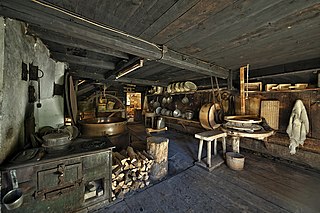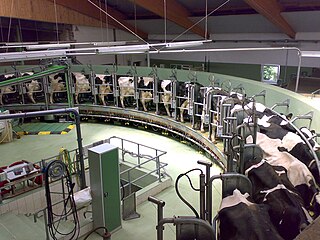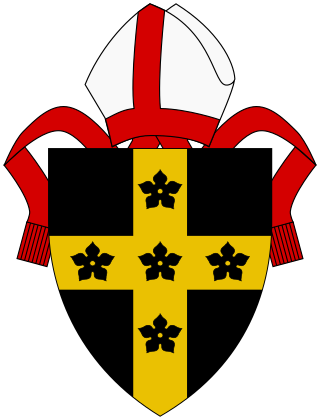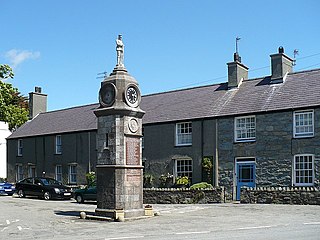
Cheddar cheese is a natural cheese that is relatively hard, off-white, and sometimes sharp-tasting. Cheddar originates from the English village of Cheddar in Somerset.

Veal is the meat of calves, in contrast to the beef from older cattle. Veal can be produced from a calf of either sex and any breed; however, most veal comes from young male calves of dairy breeds which are not used for breeding. Generally, veal is more expensive by weight than beef from older cattle. Veal production is a way to add value to dairy bull calves and to utilize whey solids, a byproduct from the manufacturing of cheese.

A dairy is a place where milk is stored and where butter, cheese and other dairy products are made, or a place where those products are sold. It may be a room, a building or a larger establishment. In the United States, the word may also describe a dairy farm or the part of a mixed farm dedicated to milk for human consumption, whether from cows, buffaloes, goats, sheep, horses or camels.

The Holstein Friesian is an international breed or group of breeds of dairy cattle. It originated in the Dutch provinces of North Holland and Friesland and in Schleswig-Holstein in northern Germany. It is the dominant breed in industrial dairy farming worldwide, and is found in more than 160 countries. It is known by many names, among them Holstein, Friesian and Black and White.

Dairy farming is a class of agriculture for long-term production of milk, which is processed for eventual sale of a dairy product. Dairy farming has a history that goes back to the early Neolithic era, around the seventh millennium BC, in many regions of Europe and Africa. Before the 20th century, milking was done by hand on small farms. Beginning in the early 20th century, milking was done in large scale dairy farms with innovations including rotary parlors, the milking pipeline, and automatic milking systems that were commercially developed in the early 1990s.

Dairy cattle are cattle bred for the ability to produce large quantities of milk, from which dairy products are made. Dairy cattle generally are of the species Bos taurus.

Penbryn is a small coastal village and community in Ceredigion, Wales, about 8 miles (13 km) from Cardigan.

The Diocese of St Davids is a diocese of the Church in Wales, a church of the Anglican Communion. The diocese covers the historic extent of Ceredigion, Carmarthenshire and Pembrokeshire, together with a small part of western Glamorgan. The episcopal see is the Cathedral Church of St David in the City of St Davids, Pembrokeshire. The present cathedral, which was begun in 1181, stands on the site of a monastery founded in the 6th century by Saint David.

Llangynog is a small rural community located in Carmarthenshire, Wales the main settlement of which was once called ‘Ebenezer’village. It is bordered by the communities of: Newchurch and Merthyr; Carmarthen; Llangain; Llansteffan; Laugharne Township; and St Clears, all being in Carmarthenshire. The population at the 2011 census was 492.
Pont Llanio railway station was a railway station in Wales on the former Carmarthen to Aberystwyth Line near Llanddewi Brefi.

Llanfechell is a village in Anglesey, Wales. It is the largest of several small villages and dispersed settlements that make up Mechell Community Council area. It is 11 miles (18 km) east of Holyhead, and 5.6 miles (9 km) west of Amlwch, in the north of the island.

Milk tank wagons were a common sight on railways in the United Kingdom from the early 1930s to the late 1960s. Introduced to transport raw milk from remote dairy farms to central creameries, milk trains were the last railway-based system before the move to road transport.

Llanybydder railway station also Llanybyther railway station served the town of Llanybydder on the Carmarthen Aberystwyth Line in the Welsh counties of Carmarthenshire and extending into Ceredigion.

A milk churn is a tall, conical or cylindrical container for the transportation of milk. It is sometimes referred to as a milk can.

Waen is a sparsely populated community in the Vale of Clwyd, in the Welsh county of Denbighshire. It includes the hamlet of Waen Goleugoed. The former civil parish was created in 1896 from the Flintshire portion of St Asaph, and lies on the eastern bank of the River Clwyd, 2.7 miles (4.3 km) east of St Asaph, 15.4 miles (24.8 km) north west of Mold, 5.1 miles (8.2 km) north of Denbigh and 11.9 miles (19.2 km) north of Ruthin. At the 2001 census the community had a population of 245, falling slightly to 241 at the 2011 census. The North Wales Expressway (A55) crosses the community from east to west, on its route from Chester to Bangor.
Talsarn is a hamlet in the community of Nantcwnlle, Ceredigion, Wales. It lies some 16 miles (26 km) south of Aberystwyth, 64 miles (103 km) north-west of Cardiff, and 178 miles (286 km) from London. It is situated almost half-way between the towns of Lampeter and Aberaeron on the Ceredigion coast. The River Aeron passes close to Talsarn as it makes its way to the sea at Aberaeron.

Trefeurig is a community in Mid and West Wales, situated around 4 miles (6.4 km) north-east of Aberystwyth. It is a site of particular prehistoric, Roman, and Iron Age interest, and has a long history as a mining area. In 2011 the local population was estimated at around 1,771 people.
Kingaroy Butter Factory is a heritage-listed former butter factory at 67 William Street, Kingaroy, South Burnett Region, Queensland, Australia. It was designed by Waugh and Josephson and built in 1926. It was added to the Queensland Heritage Register on 9 November 2012.

South Burnett Co-operative Dairy Association Factory is a heritage-listed former factory at Macalister Street, Murgon, South Burnett Region, Queensland, Australia. It was designed by George Gerald Hutton and built in 1929 by H Taylor. It was added to the Queensland Heritage Register on 9 November 2012.

Dairy is a major industry in the state of Wisconsin. Being known for its dairy production, the state is often called "America's Dairyland." The industry is prominent in official state symbols—being displayed on the state's license plates, state's slogan, and on the state quarter.
























